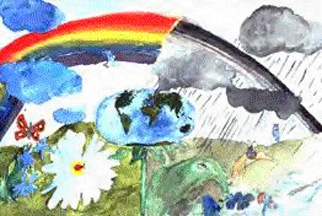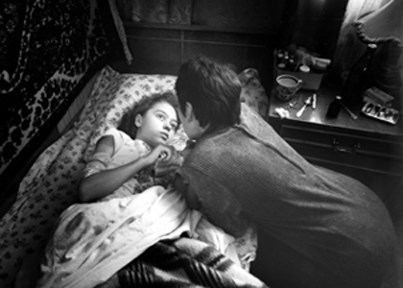 |
| 'Black Rain of Chernobyl', by Sapanco Igol, 10 years old, Ukraine. Reprint courtesy of CCFJ |
Renowned for his photojournalism skills both in Japan and around the world, Ryuichi Hirokawa is also known for his philanthropic work and his giving, compassionate soul. What makes this combination so special is that Hirokawa uses his talent to bring light to the causes he holds dear, and to expose the world to the truths he sees through his camera lens and heart.
Hirokawa was born in China in 1943 and moved to Japan at age two. In 1967, he graduated from Waseda University and moved to Israel where he entered a kibbutz. He returned to Japan in 1970, eventually becoming a photojournalist focusing on overseas assignments in the Middle East.
Throughout the years, Hirokawa received numerous awards and much-deserved recognition for his work and subject matter. Hirokawa received the 1982 Yomiuri Photo Grand Prize for his photos of the Lebanon war and Beirut massacre. In 1983, he was awarded the International Organization of Journalists Prize and, in 1989, the Kodan-sha Publishers Prize for his reports of nuclear-plant accidents in Chernobyl and Three Mile Island.
It was this series of work that would lead him to his great cause. In April 1991, Hirokawa established the "Chernobyl Children's Fund, Japan" as a fund-raising campaign. Hirokawa was motivated to do something when he visited Chernobyl after the accident and heard the great appeals made by the mothers in the Chernobyl support groups.
 |
| Photo: CHERNUISH Tanya, 14 years old. At the time of the accident, Tanya was four years old. She was exposed to radiation in Pripyat, a town near the Chernobyl Nuclear Power Station. Her thyroid-gland cancer was not discovered until it metastasized to her lungs and brain. She died on Jan. 16, 1997. |
Throughout the years, CCFJ has donated medicine, an ambulance, ultrasonic test equipment, food, relief goods and other equipment to the contaminated areas. The ambulance helps children who cannot afford to go to the hospital and delivers health exams to children in rural or remote areas. Thanks to the overwhelming response from the Japanese people, donations have amounted to 358,000,000 Japanese yen. Now, CCFJ is able to support approximately 11,550 children during their recuperations at sanatoriums in Belarus ('Hope 21) and Ukraine (Yuzhanka). Since July 1996, the organization has sent children there for recuperation and rehabilitation after thyroid gland operations. CCFJ also cooperates in the construction and management of these sanatoriums. Japanese doctors are sent to inspect the clinics.
CCFJ also helps to run a clinic opened in the evacuation area in Kiev, paying the doctors' salaries and donating medical equipment. CCFJ also bears most of the expenses of the medicine needed at the Institute of Endocrinology & Metabolism of the Ukraine for Ukrainian children having thyroid-gland operations.
Throughout the years, CCFJ has donated medicine, an ambulance, ultrasonic test equipment, food, relief goods and other equipment to the contaminated areas. The ambulance helps children who cannot afford to go to the hospital and delivers health exams to children in rural or remote areas. Thanks to the overwhelming response from the Japanese people, donations have amounted to 358,000,000 Japanese yen. Now, CCFJ is able to support approximately 11,550 children during their recuperations at sanatoriums in Belarus ('Hope 21) and Ukraine (Yuzhanka). Since July 1996, the organization has sent children there for recuperation and rehabilitation after thyroid gland operations. CCFJ also cooperates in the construction and management of these sanatoriums. Japanese doctors are sent to inspect the clinics.
Thanks both to his great talent and to his charitable work, Hirokawa received the 1993 Sankei News Children Prize for his photograph collection titled "From Chernobyl--Teacher Nina and Children." In 1998, he was awarded the Japan Journalist Congress's Special Prize for his book, "The Battlefield of Human Beings." To date, Hirokawa has published more than 40 reports and non-fiction works, including several on Chernobyl.
In 1999 Hirokawa was awarded the Japan Journalist Peace Prize for his photography collection titled "Lost 458 Villages in Chernobyl." To date, he has produced more than 14 photographic collections.
For his ability to use his courage and talents to change the world, Ryuichi Hirokawa is a modern-day hero. Seen in the eyes of thousands of children as a hero and a life-saver, Hirokawa's giving heart has given these children hope for a future. He has helped restore life to the children, their families and their entire villages.
Page created on 5/16/2007 6:25:47 AM
Last edited 1/4/2017 8:45:17 PM
Books: 'Teacher Nina and Children' and 'We Want to Live!'
Video: 'The Truth of Chernobyl'
A report of the frightfully tragic state at refugee camps in northern Afghanistan entitled "Afghanistan and People Who Die" by Ryuichi Hirokawa as published in the January 11, 2002 (no. 394) issue of "Weekly Friday" magazine with additional photos added for viewing on the web. Visit the Web Photo Exhibition
MY HERO celebrates others who aid efforts to help those effected by Chernobyl:
Adi Roche founded the Children's Chernobyl Project
Ann Armstrong-Dailey founded Children's Hospice International to help children across the world including the victims of Chernobyl.
Hirokawa photo by Eric Pride Aux from:
the Japan Reference website.
